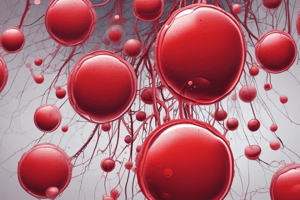Podcast
Questions and Answers
What is the primary function of thrombosthenin in platelets?
What is the primary function of thrombosthenin in platelets?
- To enable shape changes and clot retraction (correct)
- To act as a receptor
- To produce more platelets
- To form the membrane
Platelets have a nucleus that helps them in their functioning.
Platelets have a nucleus that helps them in their functioning.
False (B)
What are the types of granules found in platelets?
What are the types of granules found in platelets?
Alpha granules, Dense granules, Lysosomes
Platelets originate from the fragmentation of __________.
Platelets originate from the fragmentation of __________.
Which of the following is NOT a component found in alpha granules?
Which of the following is NOT a component found in alpha granules?
Match the types of granules with their contents:
Match the types of granules with their contents:
Microscopic tubular systems in the cytoplasm of platelets assist in communication with plasma.
Microscopic tubular systems in the cytoplasm of platelets assist in communication with plasma.
What maintains the shape of a platelet cell?
What maintains the shape of a platelet cell?
What is the normal platelet count range?
What is the normal platelet count range?
Platelets have an average lifespan of 7-10 days in circulation.
Platelets have an average lifespan of 7-10 days in circulation.
What is the process by which damaged platelets are removed from circulation?
What is the process by which damaged platelets are removed from circulation?
Thrombocytopenia refers to a condition characterized by a __________ in the number of platelets.
Thrombocytopenia refers to a condition characterized by a __________ in the number of platelets.
Match the following platelet disorders with their causes:
Match the following platelet disorders with their causes:
Which of the following factors may regulate the production of platelets?
Which of the following factors may regulate the production of platelets?
Macrophages are involved in the destruction of old platelets.
Macrophages are involved in the destruction of old platelets.
Platelets are essential in the __________ of bleeding.
Platelets are essential in the __________ of bleeding.
Flashcards
Platelet Formation
Platelet Formation
Platelets form in the cytoplasm, then detach and mature, leaving the nucleus to degenerate.
Platelet Function
Platelet Function
Platelets stop bleeding by forming a plug in damaged blood vessels and releasing clotting factors.
Normal Platelet Count
Normal Platelet Count
A healthy platelet count is around 250,000 per microliter of blood.
Platelet Lifespan
Platelet Lifespan
Signup and view all the flashcards
Platelet Destruction
Platelet Destruction
Signup and view all the flashcards
Thrombocytopenia
Thrombocytopenia
Signup and view all the flashcards
Causes of Thrombocytopenia
Causes of Thrombocytopenia
Signup and view all the flashcards
Platelet Function Disorders
Platelet Function Disorders
Signup and view all the flashcards
Platelet Structure
Platelet Structure
Signup and view all the flashcards
Platelet Membrane Receptors
Platelet Membrane Receptors
Signup and view all the flashcards
Thrombosthenin Function
Thrombosthenin Function
Signup and view all the flashcards
Platelet Granules
Platelet Granules
Signup and view all the flashcards
Platelet Origin
Platelet Origin
Signup and view all the flashcards
Platelet Formation (Megakaryocyte - Platelet)
Platelet Formation (Megakaryocyte - Platelet)
Signup and view all the flashcards
Platelet Adhesion
Platelet Adhesion
Signup and view all the flashcards
Study Notes
Platelets
- Smallest blood cells, forming a creamy layer on top of white cells after centrifugation
- Round or oval shaped, approximately 1.5 µm in diameter
- No nucleus, but packed with granules, bound by a membrane
- Shape maintained by microtubules, extensive folded membrane, and tubular system in cytoplasm
- Membrane receptors for collagen, activators, von Willebrand factor for adhesion to vessel walls and to each other during haemostasis
- Contractile proteins (thrombosthenin) involved in shape changes, aggregation, and clot retraction
- Cytoplasmic granules (alpha, dense, lysosomes) with various factors for vasoconstriction, aggregation, coagulation, wound healing
- Alpha granules: fibrinogen, factor V, thrombaspondin, von Willebrand factor, platelet-derived growth factor
- Dense granules: ADP, serotonin, calcium
- Lysosomes: hydrolytic enzymes
Platelet Development
- Originate from megakaryocytes, which stem from pluripotent stem cells in the bone marrow
- Megakaryoblast -> pro-megakaryocyte -> megakaryocyte -> platelet
- Megakaryocyte maturation: reduplication of nucleus, maturation of cytoplasm, and loss of basophilia
- Platelets formed by cytoplasmic pseudopodia penetrating sinusoids, or vesicle formation within cytoplasm, fragmenting and releasing platelets, leaving behind the nucleus
Platelet Functions
- Arrest bleeding through platelet plug formation, secretion of substances for coagulation and clot retraction.
Normal Platelet Values
- Normal range is 150-400 x 10³/µL, mean around 250 x 10³/µL
Platelet Lifespan
- Approximately 9-12 days
Platelet Destruction
- Phagocytosis by macrophages in the spleen
Platelet Regulation
- Number fairly constant, production matches destruction, but mechanism unclear
- Factors like thrombopoietin related to colony stimulating factors may be involved.
Platelet Disorders
- Thrombocytopenia (low platelet count) can result from various mechanisms, such as failure of maturation, marrow hypoplasia, infiltration, consumption (DIC), or drug-induced effects
- Platelet Function Disorders:
- Defective adhesion (low/absent von Willebrand factor or receptors)
- Defective aggregation (e.g., aspirin)
- Defective release reaction (e.g., aspirin)
- Excessive destruction (e.g., enlarged spleen in certain conditions like malaria or portal hypertension)
Studying That Suits You
Use AI to generate personalized quizzes and flashcards to suit your learning preferences.





